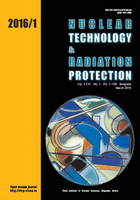
COMPARISON OF PASSIVE AND ACTIVE RADON MEASUREMENT METHODS FOR PERSONAL OCCUPATIONAL DOSE ASSESSMENT
Pages: 73-78
Authors: Elham Hasanzadeh, Fereidoun Mianji, Asghar Sadighzadeh, and Farhang Mizani
Abstract
To compare the performance of the active short-term and passive long-term radon measurement methods, a study was carried out in several closed spaces, including a uranium mine in Iran. For the passive method, solid-state nuclear track detectors based on Lexan polycarbonate were utilized, for the active method, AlphaGUARD. The study focused on the correlation between the results obtained for estimating the average indoor radon concentrations and consequent personal occupational doses in various working places. The repeatability of each method was investigated, too. In addition, it was shown that the radon concentrations in different stations of the continually ventilated uranium mine were comparable to the ground floor laboratories or storage rooms (without continual ventilation) and lower than underground laboratories.
Key words: active measurement, AlphaGUARD, passive measurement, radon, solid-state nuclear track detector
FULL PAPER IN PDF FORMAT (2.04 MB)
